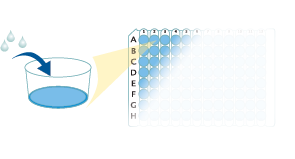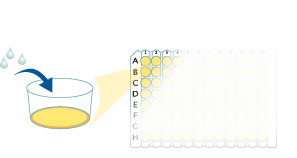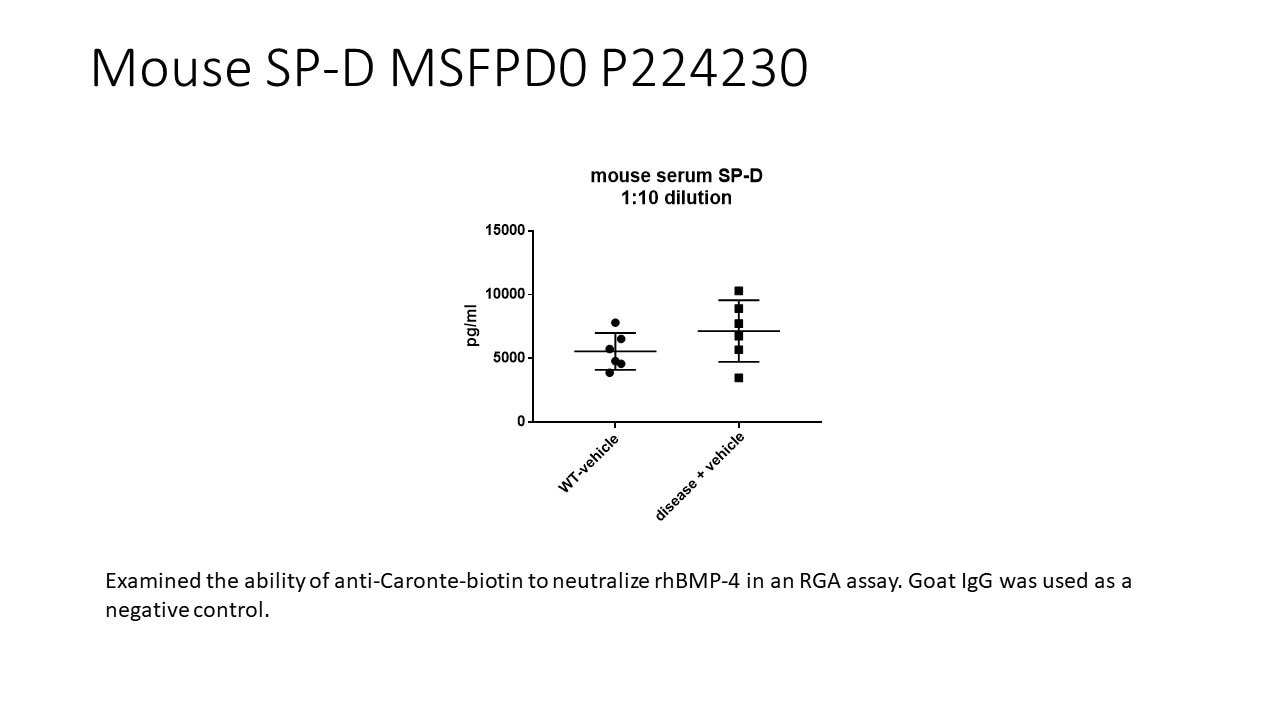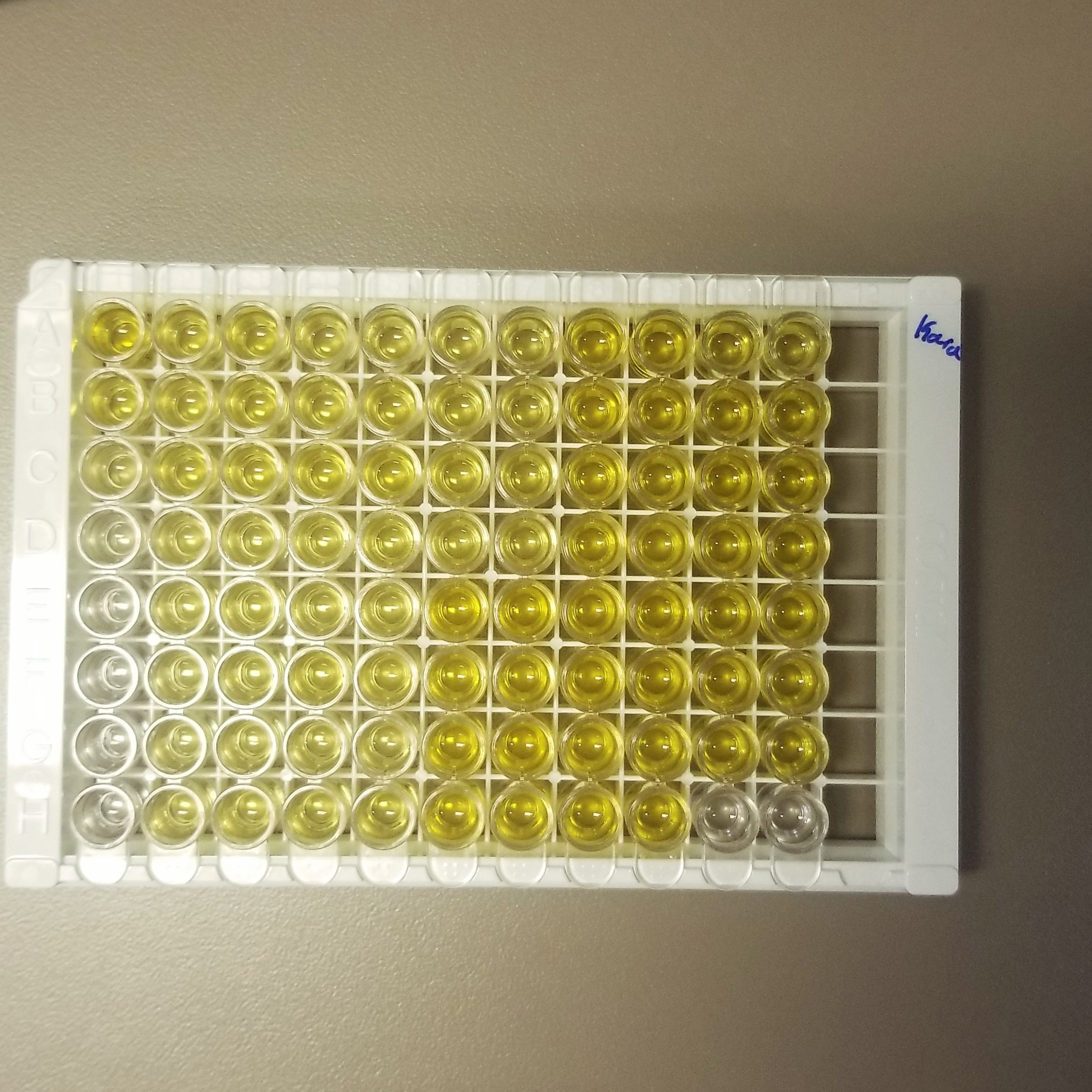Mouse SP-D Quantikine ELISA Kit Summary
Product Summary
Precision
Cell Culture Supernates, Tissue Lysates, Serum, EDTA Plasma, Heparin Plasma
| Intra-Assay Precision | Inter-Assay Precision | |||||
|---|---|---|---|---|---|---|
| Sample | 1 | 2 | 3 | 1 | 2 | 3 |
| n | 4 | 4 | 4 | 4 | 4 | 4 |
| Mean (pg/mL) | 158 | 534 | 1270 | 169 | 531 | 1267 |
| Standard Deviation | 5.75 | 13.8 | 43 | 14 | 34.4 | 120 |
| CV% | 3.6 | 2.6 | 3.4 | 8.3 | 6.5 | 9.5 |
Recovery
The recovery of mouse SP-D spiked to levels throughout the range of the assay in various matrices was evaluated.
| Sample Type | Average % Recovery | Range % |
|---|---|---|
| Cell Culture Media (n=4) | 99 | 92-105 |
| EDTA Plasma (n=4) | 97 | 90-103 |
| Heparin Plasma (n=4) | 97 | 84-104 |
| Serum (n=4) | 96 | 84-109 |
| Tissue Lysates (n=4) | 101 | 91-113 |
Linearity
Scientific Data
Product Datasheets
Preparation and Storage
Background: SP-D
Surfactant Protein D (SP-D) is a collectin family protein consisting of a collagen-like sequence followed by a C-type lectin domain. It is synthesized primarily in the lung by alveolar type II cells and unciliated bronchial epithelial cells. In addition, SP-D is produced by epithelial cells of the gastrointestinal tract and exocrine glands. SP-D binds to patterns of neutral sugars on micro-organisms to mediate direct opsonization and phagocytosis and is an important component of the innate immune system.
Assay Procedure
Refer to the product- Prepare all reagents, standard dilutions, and samples as directed in the product insert.
- Remove excess microplate strips from the plate frame, return them to the foil pouch containing the desiccant pack, and reseal.
- Add 50 µL of Assay Diluent to each well.
- Add 50 µL of Standard, Control, or sample to each well. Cover with a plate sealer, and incubate at room temperature for 2 hours on a horizontal orbital microplate shaker.
- Aspirate each well and wash, repeating the process 3 times for a total of 4 washes.
- Add 100 µL of Conjugate to each well. Cover with a new plate sealer, and incubate at room temperature for 2 hours on the shaker.
- Aspirate and wash 4 times.
- Add 100 µL Substrate Solution to each well. Incubate at room temperature for 30 minutes on the benchtop. PROTECT FROM LIGHT.
- Add 100 µL of Stop Solution to each well. Read at 450 nm within 30 minutes. Set wavelength correction to 540 nm or 570 nm.





Citations for Mouse SP-D Quantikine ELISA Kit
R&D Systems personnel manually curate a database that contains references using R&D Systems products. The data collected includes not only links to publications in PubMed, but also provides information about sample types, species, and experimental conditions.
4
Citations: Showing 1 - 4
Filter your results:
Filter by:
-
NETs Promote Inflammatory Injury by Activating cGAS-STING Pathway in Acute Lung Injury
Authors: J Zhao, N Zhen, Q Zhou, J Lou, W Cui, G Zhang, B Tian
International Journal of Molecular Sciences, 2023-03-07;24(6):.
Species: Mouse
Sample Types: Serum
-
Change of surfactant protein D and A after renal ischemia reperfusion injury
Authors: IM Imtiazul, R Asma, JH Lee, NJ Cho, S Park, HY Song, HW Gil
PLoS ONE, 2019-12-26;14(12):e0227097.
Species: Mouse
Sample Types: Serum
-
Macrophage migration inhibitory factor enhances influenza-associated mortality in mice
Authors: CA Smith, DJ Tyrell, UA Kulkarni, S Wood, L Leng, RL Zemans, R Bucala, DR Goldstein
JCI Insight, 2019-07-11;4(13):.
Species: Mouse
Sample Types: Serum
-
Stat5 Is Required for CD103(+) Dendritic Cell and Alveolar Macrophage Development and Protection from Lung Injury
Authors: WE Eddy, KQ Gong, B Bell, WC Parks, SF Ziegler, AM Manicone
J. Immunol., 2017-05-12;0(0):.
Species: Mouse
Sample Types: BALF
FAQs
No product specific FAQs exist for this product, however you may
View all ELISA FAQsReviews for Mouse SP-D Quantikine ELISA Kit
Average Rating: 4.5 (Based on 2 Reviews)
Have you used Mouse SP-D Quantikine ELISA Kit?
Submit a review and receive an Amazon gift card.
$25/€18/£15/$25CAN/¥75 Yuan/¥2500 Yen for a review with an image
$10/€7/£6/$10 CAD/¥70 Yuan/¥1110 Yen for a review without an image
Filter by:
I used this kit to analyze SP-D of FVBN mice plasma and BAL infected with 0111:B4 LPS. I had a lot of background signal which made it hard to distinguish the difference of SP-D between control and infected mice. I think the kit itself is good and easy to use though, I just need to increase the difference to compensate for background noise. I also didn't dilute enough in my BAL, so my std curve was not allowed to develop as much as I would have liked. If you run with BAL I would recommend a 1:500 dilution! I did 1:200.






